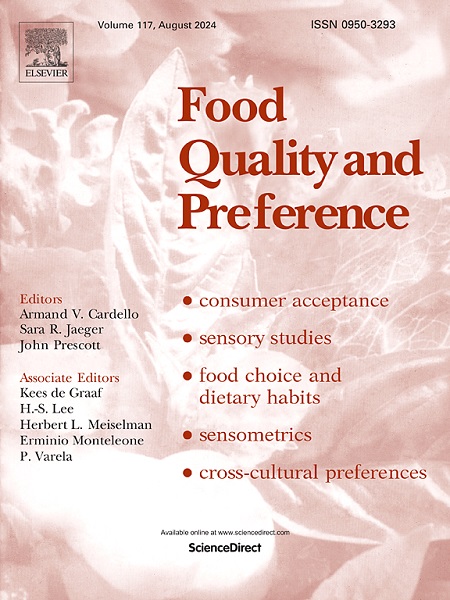营养标签对促进食品图像检测的影响
IF 4.9
1区 农林科学
Q1 FOOD SCIENCE & TECHNOLOGY
引用次数: 0
摘要
现代社会中大量的低能量食品意味着消费者经常接触到具有相似感官特征但营养价值不同的食品(例如,含糖或无糖饮料)。感官线索和营养成分之间的不一致被认为会损害饮食调节机制,如风味-营养学习和条件饱腹感。这项研究旨在检查营养标签是否可以作为抵消这种假定损害的工具。具体来说,我们研究了营养标签是否可以调节先前观察到的对食物刺激的注意偏向。在两个实验中,我们探讨了(1)注意偏倚是否受到食物营养价值的影响(实验1)和(2)这种偏倚是否可以通过喂食前阶段进行调节(实验2)。在喂食前阶段,参与者食用带有或不带有标明高或低热量含量的营养标签的食物。我们的结果重复了对食物的注意偏倚受其营养价值调节的发现。然而,营养标签的影响仍然没有定论。未来的研究应该探索是否将这种方法与其他营养标签格式一起使用会更有效。本文章由计算机程序翻译,如有差异,请以英文原文为准。
The effect of nutritional labels on the facilitation of food image detection
The abundance of reduced-energy food products in modern society means consumers are frequently exposed to foods with similar sensory characteristics but differing nutritional values (e.g., sugar or sugar-free beverages). This inconsistency between sensory cues and nutritional content has been suggested to impair eating regulatory mechanisms such as flavor-nutrient learning and conditioned satiety. This research aimed to examine whether nutritional labels can serve as a tool to counteract this presumed impairment. Specifically, we investigated whether nutritional labels could modulate the previously observed attentional bias toward food stimuli. Across two experiments, we explored (1) whether attentional bias is influenced by the nutritional value of the food (Experiment 1) and (2) whether this bias can be modulated by a pre-feeding phase in which participants consumed a food item presented either with or without a nutritional label that signaled high or low caloric content (Experiment 2). Our results replicate the finding that attentional biases toward foods are modulated by their nutritional value. However, the effect of nutrition labels remains inconclusive. Future research should explore whether using this methodology with alternative nutritional label formats would be more effective.
求助全文
通过发布文献求助,成功后即可免费获取论文全文。
去求助
来源期刊

Food Quality and Preference
工程技术-食品科技
CiteScore
10.40
自引率
15.10%
发文量
263
审稿时长
38 days
期刊介绍:
Food Quality and Preference is a journal devoted to sensory, consumer and behavioural research in food and non-food products. It publishes original research, critical reviews, and short communications in sensory and consumer science, and sensometrics. In addition, the journal publishes special invited issues on important timely topics and from relevant conferences. These are aimed at bridging the gap between research and application, bringing together authors and readers in consumer and market research, sensory science, sensometrics and sensory evaluation, nutrition and food choice, as well as food research, product development and sensory quality assurance. Submissions to Food Quality and Preference are limited to papers that include some form of human measurement; papers that are limited to physical/chemical measures or the routine application of sensory, consumer or econometric analysis will not be considered unless they specifically make a novel scientific contribution in line with the journal''s coverage as outlined below.
 求助内容:
求助内容: 应助结果提醒方式:
应助结果提醒方式:


